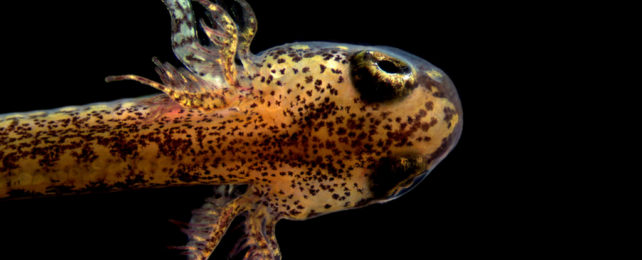Lungs. We can't live without them, nor can most animals that wear their skeletons on the inside. However, some extraordinary amphibians no longer bother with these delicate, mucus-y organs.
Scientists have discovered that some lungless animals start to grow these breathing organs at first, and then their developmental process has a change of heart.
These animals, the plethodontid salamanders, have gotten away with being lungless by breathing through their slimy skin and mouth tissues instead for at least 25 million years. To do this, they must coat themselves with goo – like they're wearing their lung mucus on their outsides – because they can only absorb oxygen through their skin if it remains moist.
Lungless plethodontids are the biggest group of salamanders with almost 478 species, found mainly in the Americas, with a few in Europe and South Korea.
Little is known about how these amphibians misplace their lungs, so Harvard University evolutionary biologist Zachary Lewis and colleagues took a closer look at these cold-blooded water lovers.
"We confirm that an incipient lung does form in embryos of several species," the researchers write in their paper. "Its morphological features closely resemble those seen in the axolotl, Ambystoma mexicanum, a lunged salamander."
These embryonic lungs develop and branch out for around three weeks in one species, P. cinereus, before something interrupts them. Well before the baby salamanders hatch, the early lung cells are programmed to undergo apoptosis, a form of cell death.
The researchers suspect lung development stops because the cells don't receive the regulatory signals needed to keep them multiplying, which in other vertebrates comes from the tissues surrounding the developing lungs called mesenchyme. So they decided to test this hypothesis.
"We put mesenchyme from a salamander with lungs into a lungless salamander embryo and allowed it to develop," says Lewis. "It resulted in the formation of structures that resemble lungs, offering some evidence that lungless salamanders remain capable of continuing to develop lungs."
While these mucus-covered animals have no traces of lungs within them as adults, salamanders still have the genes and many of the developmental processes needed to grow them.
But some of the signals required to complete the process – those from the mesenchyme tissues, for example – appear to be missing.
So why have so many of the tools and ingredients for lung making been preserved in animals that haven't used lungs for millions of years?
"The lung rudiment, for example, may play important roles in the development of adjacent organs such as the heart," the researchers speculate, explaining that some of the genes involved in initial lung formation are also used to make other organs. For example, a gene called Sonic hedgehog (yes, really) is used for both lung and limb development.
These connections show how studying organ remnants (vestigial structures) – like these or leg nubs in snakes – can help us understand the twisting and turning mechanisms behind developmental and evolutionary processes and provide insights into the workings of our organs.
Sparse fossil records of salamanders make it hard for researchers to narrow down when precisely these animals lost their dedicated breathing organs, but genetic timelines put it somewhere between 25 to 110 million years ago, depending on if it happened in one ancestral species or if lung loss evolved multiple times within this salamander family.
"Clearly lungless salamanders do fine without lungs given that they make up about two-thirds of all salamander species," says Lewis. "Perhaps losing lungs enabled, rather than hindered, this remarkable evolutionary success."
This research was published in Science Advances.
